November 24th, 2015 · 3 Comments
Previously when traveling internationally we have had to get SIM cards for our phones in each country we visited. Typically it goes like this: You arrive in the country and unless you find open WiFi, your phone is pretty much useless. As soon as possible, hopefully within a day, you find a phone store and buy a SIM card and data plan. Once you get set up, you can use your phone in the country, but calling back to the US is generally quite expensive.
Before our recent trip, I switched to Google Project Fi, and set Gisele up with T-Mobile’s Simple Choice plan. Both of these plans include international service in over 140 countries. It was great. As soon as we landed at the airport, we turned the phones on and usually before we arrived at the gate we had service. This worked in Hong Kong, Sydney, Singapore and Taiwan (and Canada a couple of months ago).
In some countries you can buy a SIM and service for cheaper than we paid for T-Mobile, but the convenience was well worth the few dollars we would have saved (besides, to take advantage of that savings we would have had to cancel our domestic phone service at the start of the trip and reinstated after we returned). Being able to simply use the phones wherever we went was really nice.
The main drawback is that data is limited to about 128 kb/s on Simple Choice when out of the US (I get 256 kb/s with Project Fi). That’s too slow to stream video, but for email, WhatsApp and simple web browsing it is fine. We also noticed that when calling each other there was a very long lag that sometimes led to confusion, until we started talking through WhatsApp’s phone service. It might be that the normal phone service routes our calls through the USA and back, causing double the normal international lag.
I know that T-Mobile doesn’t have as good of coverage in the US as some of their competitors, but with few exceptions it’s been fine for us. And with their international coverage I can’t imagine us switching unless there is better competition. Anyone who travels out of the country a lot should consider it as an option.
As a side note, T-Mobile has just introduced their unlimited video through Netflix, Sling, Hulu, etc. (not YouTube), which sounds interesting though I haven’t tried it or checked out the details.
Tags: Uncategorized
November 13th, 2015 · 1 Comment
We arrived in Taiwan after an unpleasant flight from Sydney. The flights were OK, but the 5-hour layover in Singapore and the 5:30 am arrival were not. And we couldn’t check into the hotel until 2 pm. So we were just hanging out at street markets, until Devon told us he was recording a TV show that morning and asked if we wanted to come watch. So we did, and though we were tired, with a little coffee we enjoyed the event. We got to meet some mid-level Taiwan celebrities (Devon would be considered low level), and watch a show be produced.

Devon is on the far left.
We went out with Devon for dinner after, then the next day we met his latest girlfriend, Mia.
We discovered yesterday that a friend is getting married in Taipei this morning. We know the groom and his parents in Tempe. Unfortunately it is too late to buy a tuxedo and attend, but we will try to meet up with the couple and family while we are here.
Today we are washing clothes in the morning, and probably meeting Devon and maybe Mia in the afternoon. It’s laid-back time in Taipei.
Tags: Uncategorized
November 3rd, 2015 · 4 Comments
We visited 4 islands, Isle of Pines, Mare, Lifou and the main New Caledonia island. All of the islands belong politically to New Caledonia. Each was larger than the last from the roughly 5 x 7 mile Isle of Pines to the 200 mile-long New Caledonia.
I think Isle of Pines was my favorite, unfortunately the one island that Gisele didn’t get to see since she was sick and quarantined. Though the island is small, the beaches were incredible even with 2000 cruise ship passengers infesting them. I’ve never seen a turquoise to match the colors of the ocean. I’m sure there are Caribbean islands to match, though I’ve only ever seen Barbados and Puerto Rico in the Caribbean and they don’t compare.
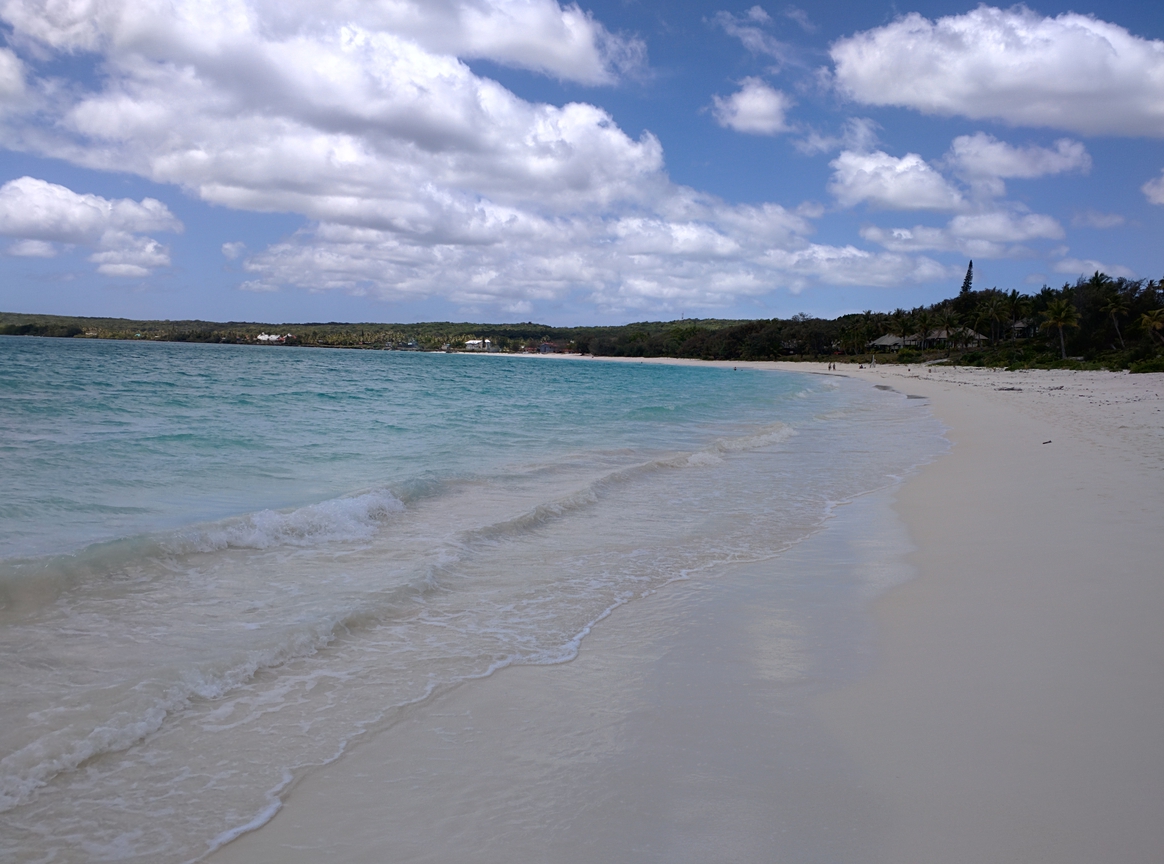
Lifou, very similar to beaches on the other islands.
When the cruise ships depart, the population falls to a few hundred and the beaches are mostly deserted. It would be an idyllic place to spend a week or two.
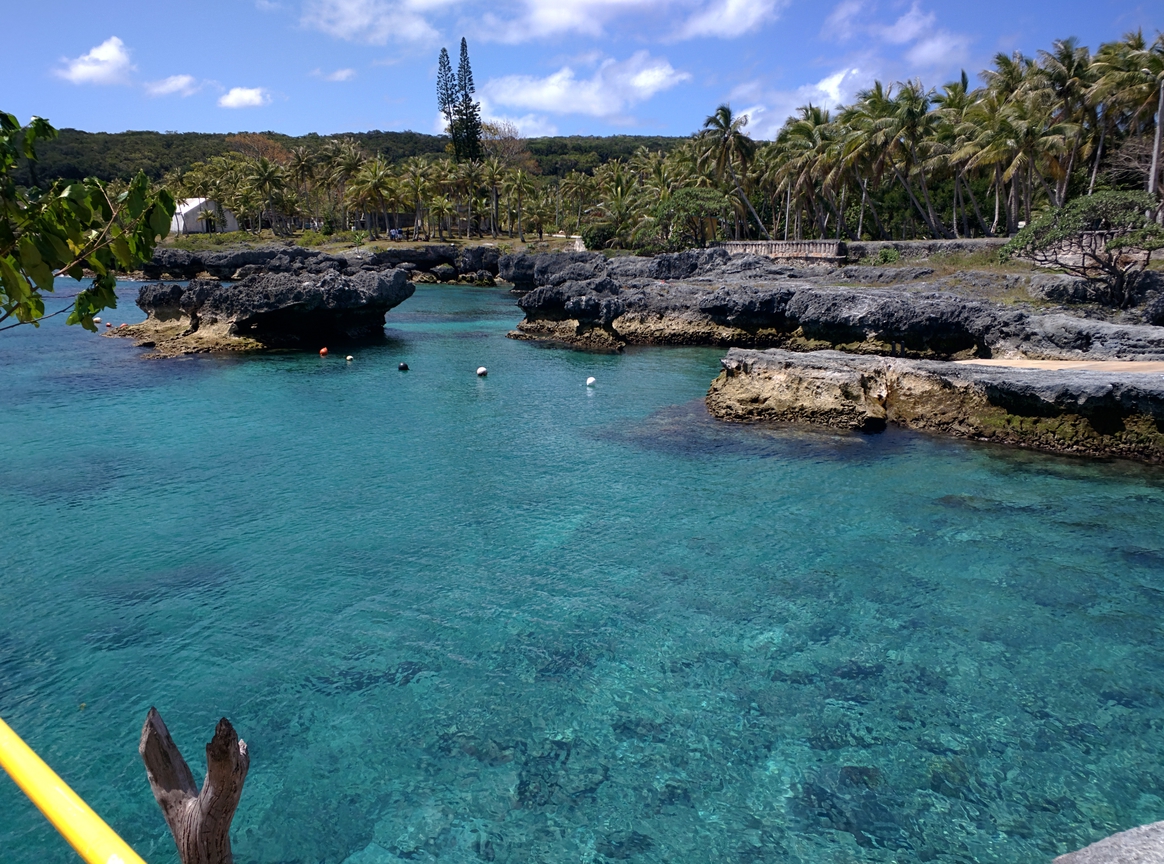
Mare and Lifou were larger versions of the Isle of Pines, with more people, roads and a little more commercialization, but the vendors were all very laid back, waiting for you to come to them rather than calling out or pushing their wares. It was nice.

This lady opened a fresh coconut with a machete, and stuck a straw in it for me to drink. Delicious!
On the big island I did a couple of excursions on my own, since none of the rest of my party wanted to join me. In the morning I took a guided Segway tour through a zoological and botanical garden near the city of Noumea. It was lots of fun, more for the Segway than the biology. The guide didn’t really know much except what she had picked up casually from working there. For example, she called a pea-hen a “female peacock”. But it was still a lot of fun and I did learn a lot. Now I am tempted to buy a Segway, but I really can’t think how I would use it except to go get the mail once a day.
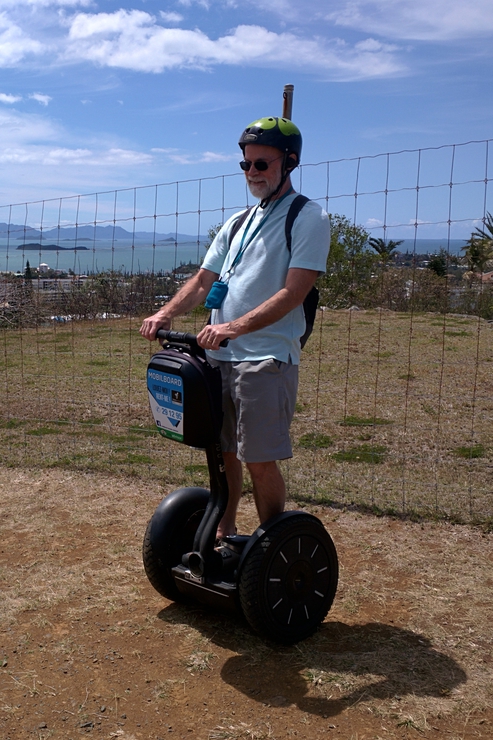
In the afternoon I went on a 6 mile guided bike ride. The European guide actually knew more than the garden guide had that morning, and I learned a lot about life in New Caledonia. It is much more civilized than I had expected with about 250,000 people on the island, and 180,000 of those in the city of Noumea. She made it sound like a true paradise with low crime and a prosperous middle class. She had apparently come to visit a couple of years ago and liked it so much she had settled in.
New Caledonia was apparently part of Australia a few million years ago that broke off and moved north-east. There are similarities of plants and birds, but it’s been long enough that they have diverged evolutionarily to be quite different. I was surprised that there are around 15 species of pine, a tree that I usually associate with mountains and temperate forests rather than the tropics.
The original people of New Caledonia were Melanesian, quite different from the Polynesians of Hawaii and Tahiti. Melanesians are more closely related to the dark skinned Australian aborigines, while the Polynesians are closer to the people of south east Asia and the Philippines. In Noumea the Melanesians are now a minority, though still a plurality, with Europeans coming in second and the rest made up of Polynesians and Asians.

This typical Melanesian drove us around Mare Island in a van.
Now we are on our way back to Sydney, a 2 ½ day sail. Looking out and seeing nothing but water from horizon to horizon for two days gives me some idea of the vastness of the oceans, especially considering that we are only crossing a small corner of the south Pacific. I saw some rain storms not too far away this morning, but unfortunately we didn’t pass through any and it is clearing off now. The captain says the weather should be clear all the way home. I was looking forward to a storm at sea.

From our balcony on the way back to Sydney.
Tags: Uncategorized
November 3rd, 2015 · 1 Comment
We departed Sydney on Monday evening. It’s now Wednesday afternoon, and we are still sailing north-east on our way to New Caledonia and neighboring islands. We should arrive at the Isle of Pines tomorrow morning, an island named by the famous Captain James Cook because of the pine forests that grow in the islands. There was some rain yesterday, but today is mostly clear, with just a few clouds on the horizon. The sea is very calm; not glassy but very smooth. We can only feel very little rocking of the ship.
Gisele is sick. She woke up vomiting this morning at 3:00am, and went to see the ship’s doctor after they opened at 8:00 am. No fever, BP normal, and they gave her Imodium and anti-nausea medication. She is quarantined to the stateroom for at least 24 hours, though they want her symptom free for that long before they will let her off the ship. They diagnosed a simple “stomach flu”, viral GI infection. Looks like she may miss the Isle of Pines, though she may get released by the afternoon of our visit there if she improves soon.
While boarding the ship, the x-ray scan detected my satellite phone, walky-talkies and Leatherman “multi-tool”, and all were confiscated. After consulting with the captain, all were returned the next day except the satellite phone, which they said could interfere with ship communications. I asked if I could have it back for shore excursions, and they promised to consider it. We’ll see, somehow I’m doubtful that they will have a way to release it to me, and then ensure it gets back when I reboard.
*Update: They did release the satellite phone to me each time I went ashore, and I was able to use it a few times for phone calls and emails.
Tags: Uncategorized
I’ve posted several times about the trip, but here are a few more tidbits.
First, here’s a map showing our route and stops along the way.
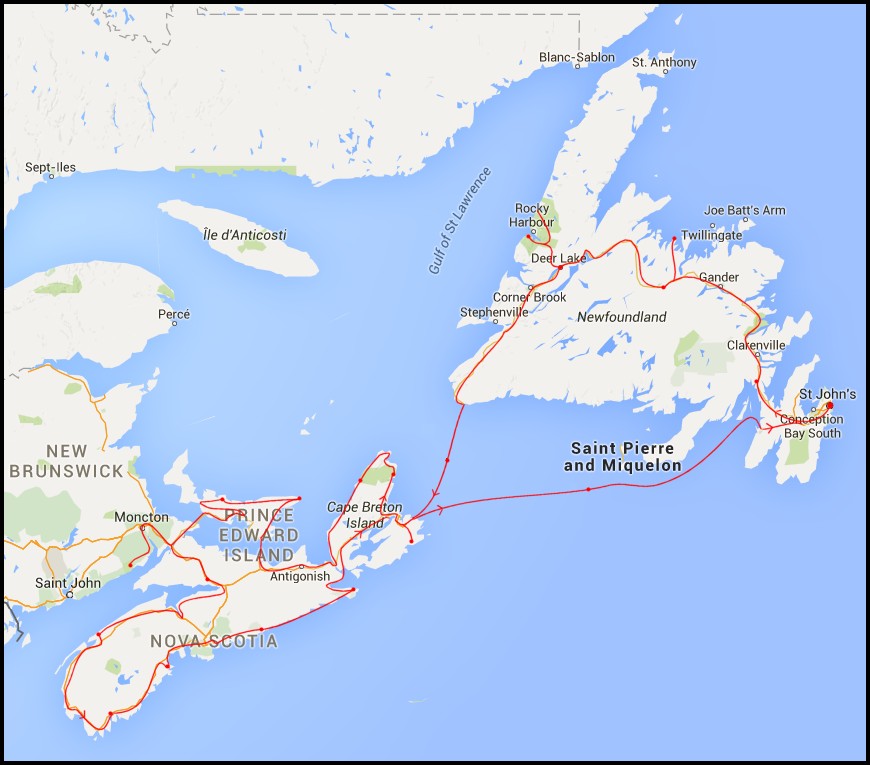
We started and finished on the far right at St. John’s, Newfoundland (not to be confused with Saint John, New Brunswick). Our direction of travel is generally counter-clockwise, starting north and west across Newfoundland. The line shows our travels, and the red circles show nights. I drew small arrows in a couple of places showing direction of travel.
You can see that we covered much of Nova Scotia and Prince Edward Island, but only a slice of Newfoundland and just a corner of New Brunswick. It’s difficult to travel in southern Newfoundland. There are no highways along the southern edge; to get to any settlements there you generally have to drive down from the main highway in the north, then back up and down again to get to another settlement. This map doesn’t show it very well, but Newfoundland (and Nova Scotia to a lesser extent) has an extremely scalloped shoreline, with long arms separated by deep straits.
I have two favorite places: The Bay of Fundy for the scientific and natural wonder of the tides, and the beautiful, peaceful Ocean View Park where we spent two nights in Leading Tickles, Newfoundland right on the beach.

Our favorite campground at the Ocean View Park in Newfoundland.

The Bay of Fundy at low tide. All these people would be covered, and more, at high tide.
Geography and Ecology
In general, Newfoundland has much more wilderness and forests, mostly evergreen. Prince Edward Island is almost the opposite, being mostly farmland with scattered deciduous woods. It reminds me a lot of western New York State. Nova Scotia is in between; more settled than Newfoundland, but more wilderness and forests than PEI.
All these provinces have long coastlines, and fishing is big business in Maritime Canada. We had some of the best lobster we have ever had, and I ate “Fish and Chips” almost every other day. Most of it was excellent, though some, of course, was only good. Gisele said she had the best mussels she has ever eaten at a restaurant on Prince Edward Island. I took her word for it.
Canadian Money
Canadian money is very similar to US money with two major differences:
– The smallest bill we saw was $5. There are $1 and $2 dollar coins, called respectively “Looneys” and “Twoneys”. It took a little getting used to the idea that there could be dollars in my coin pocket, but it’s not a bad idea and I think it saves the mint some money replacing worn bills.
– We never saw a penny in Canada. The smallest coin is a nickel, and cash payments were all rounded up or down to the nearest nickel. (Credit card bills, however, retained the cents.) Another good idea. Pennies are a nuisance, and another waste of money to mint.
Languages
French and English are both official languages in Canada, and most things are printed and generally announced in both. However, in parts of Nova Scotia, Gaelic is (apparently) still used, and we found some signs in both English and Gaelic. Here’s an example:
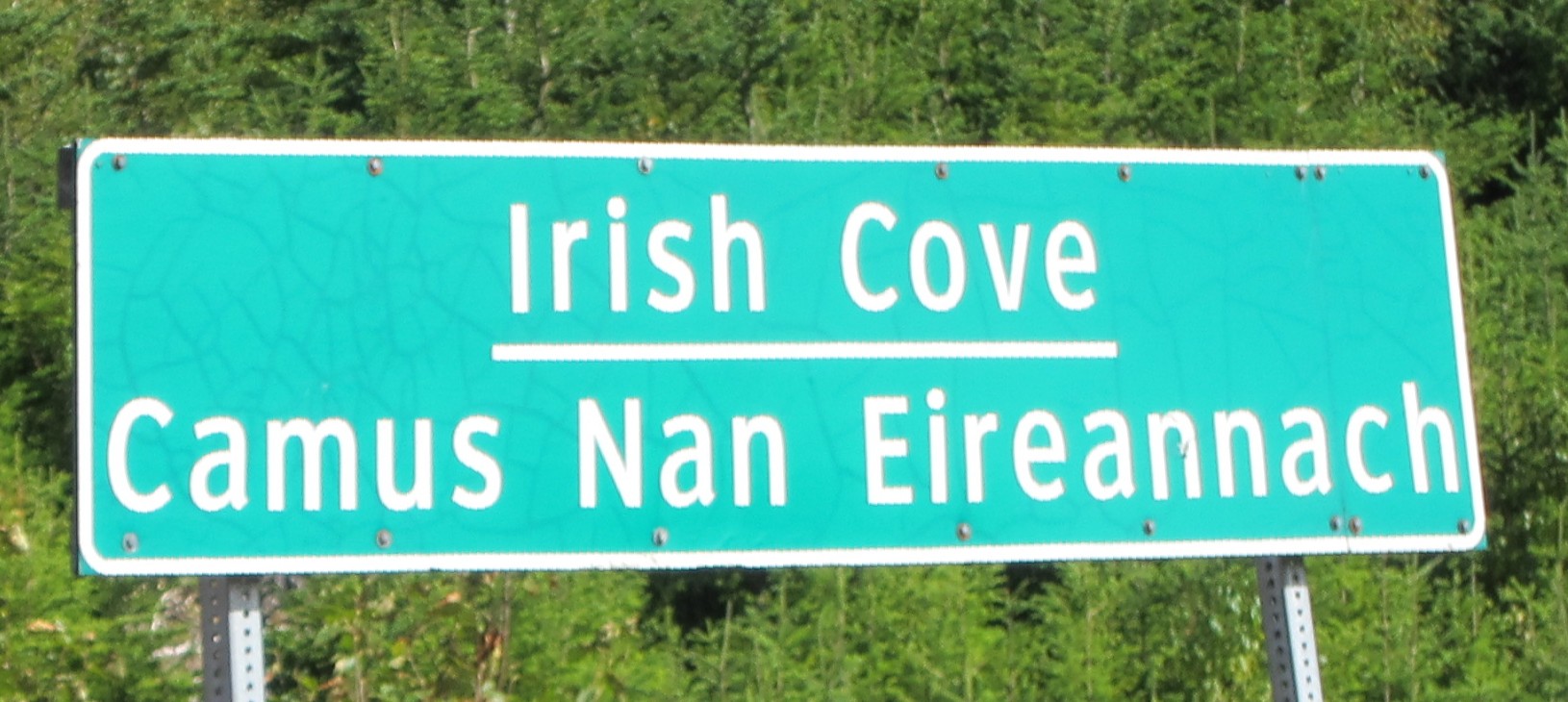
Internet, Phones, etc.
Just before leaving I switched my phone service to Google Project Fi. This gives me voice, text and data services in 140 countries, including of course Canada. It was seamless and worked well. When we arrived in Toronto Airport to change planes, I immediately had a connection, and was able to connect almost anywhere throughout our trip. A couple of exceptions were national parks far from any cities.
Gisele brought her cell phone too, but it’s not eligible for the same Project Fi, and we were unable to get a Canadian SIM for her phone, though we tried. Phone stores were rare and confined to major cities, and the one phone store we tried sounded very confused about the idea of putting their SIM into our phone, which we often have done in Taiwan, Vietnam, and other countries. They’re a little behind the times up there, communication-wise.
Most RV parks had WiFi, but with a few exceptions it was weak and slow, often unusable.
Gas Prices
In Newfoundland gasoline sold for about US$3.25/gallon. In Nova Scotia it was about US$2.90/gallon.
Credit Cards
I made a mistake and used my Chase credit card to pay for the motor home rental. I was shocked when they added a $109 foreign transaction fee to a $3500 charge. I learned my lesson and from then on used my Schwab card for everything. Schwab waives all such fees, and even reimburses ATM charges that may be charged by other banks. A card like that is the only way to go when traveling internationally.
Timmy’s
There seem to be more Tim Horton coffee shops in Canada than Starbucks in America. Affectionately referred to as “Timmy’s” their coffee is cheaper and not quite as fancy as Starbuck’s, but they make a good cup. We only saw one Starbuck’s in all of Canada, in St. John’s, but there seem to be Tim Hortons on every corner and every stop on the highway.
Did I forget anything? Probably…
Tags: Uncategorized
September 21st, 2015 · 2 Comments
We are in the south-west coastal area of Nova Scotia now, slowly making our way to the east where we will catch a ferry to Newfoundland on Friday.
Nova Scotia is Latin for “New Scotland”. I don’t know for sure where the name came from, but in parts of the province road signs are in both English and Gaelic. Apparently a lot of Scots settled here.
At a glance on the map, Nova Scotia looks like an island, but it is actually connected to New Brunswick in the north west. Parts of the province are islands, with Cape Breton Island on the far north east the outstanding example.
The first European settlers were from France, and they called the area “Acadie”. They become known as “Acadians”. They built many settlements, built dykes to keep out the sea, farmed and lived here for many years. However, in the early 1700s when Britain and France were having one of the frequent spats, the British forcibly expelled the Acadians for fear that they were helping the French. Many of them went back to France (often to return when the political climate improved), some hid in the mountains, and some went to Louisiana. Over time in Louisiana, the word “Acadian” evolved into “Cajun”, with the obvious influence they have had there.
The Acadians who returned continue to have an important presence, and we toured at least two museums dedicated to them.
Tags: Uncategorized
September 21st, 2015 · 2 Comments
Yesterday, passing through the town of Annapolis, I saw a sign for a Tidal Power station, so we stopped in to take a look.
It is one of only 5 tidal power stations in the world, according to the interpreter at the center. It consists of a one-way turbine, and only generates power as the tide goes out. When the tide comes in, they open other gates that let the water fill a basin above the turbine. Then when the tide starts out it starts generating electricity again.
At best it can put out 20 megawatts, but it varies by time of day and time of month. Like solar and wind, it does not generating 100% of the time, but unlike those it is very predictable when it will be generating and how much it will put out at any given second.
Here’s a scale model of the turbine. In the actual turbine, the diameter of the turbine blades is about 22 feet.
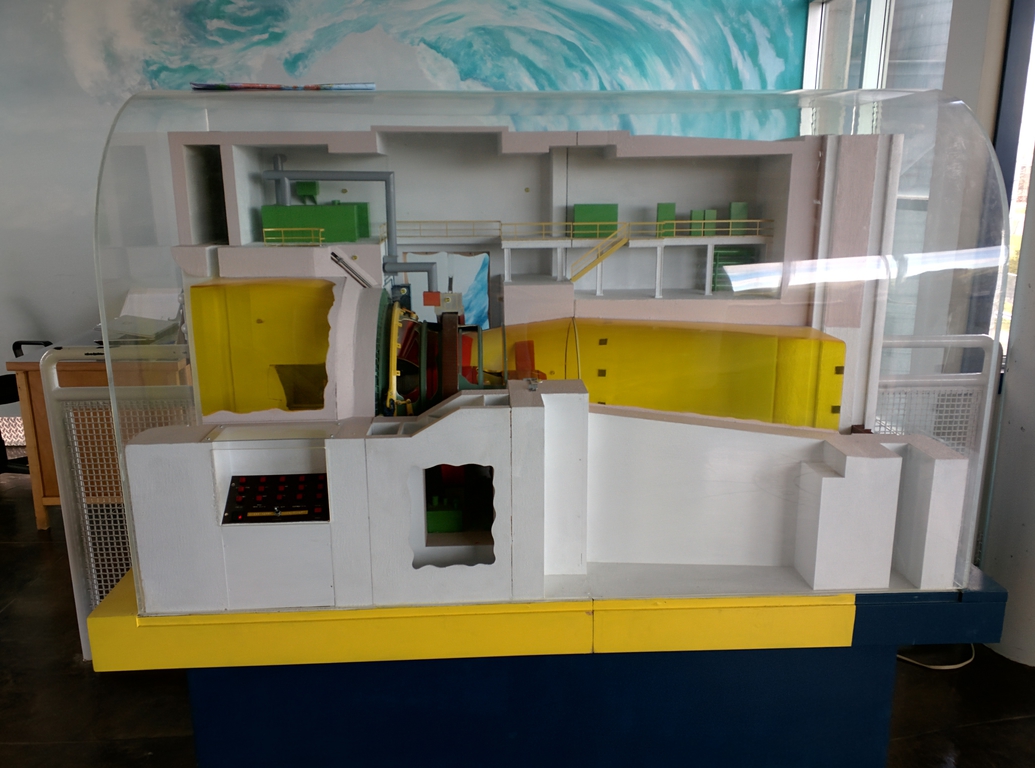
They didn’t let us tour the actual turbine, so this model, views of the water coming out below and our imagination had to fill in the picture.
Tags: Uncategorized
September 18th, 2015 · 3 Comments
We went back to the same point in the Bay of Fundy this morning to see what it was like with the tide out.
As a reminder, here’s a picture with the tide in.

Here’s what the same location looked like this morning with the tide out.
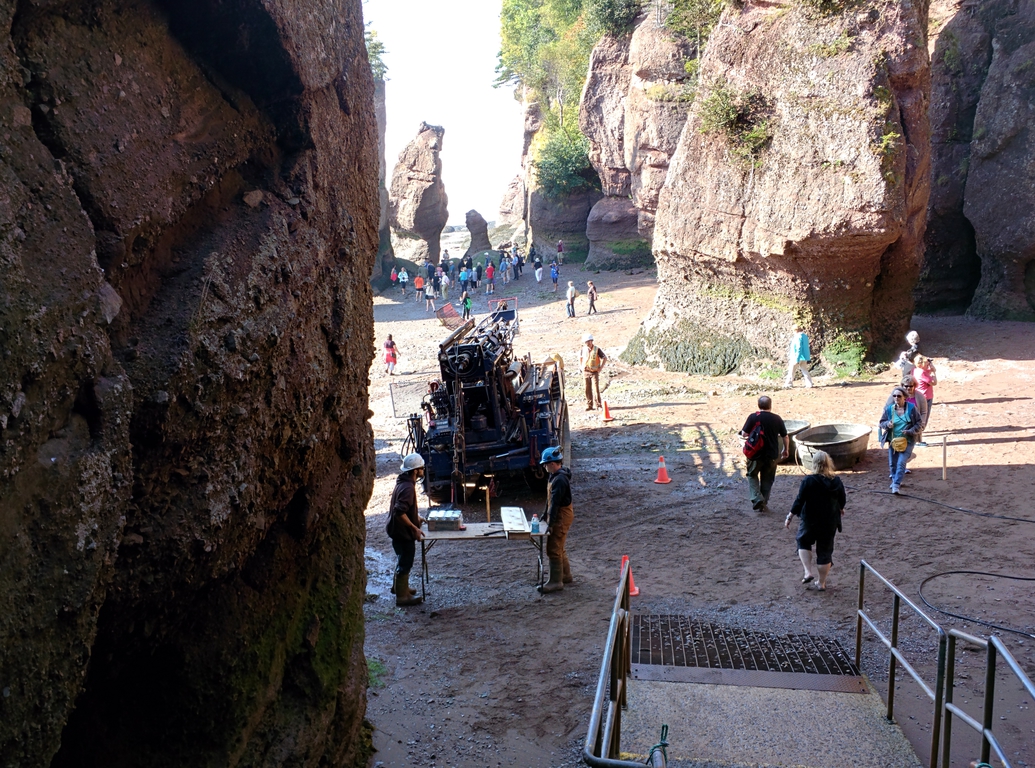
Here’s another scene down the beach a ways. All the miles of sand you see will be covered with 10s of feet of water in a few hours.
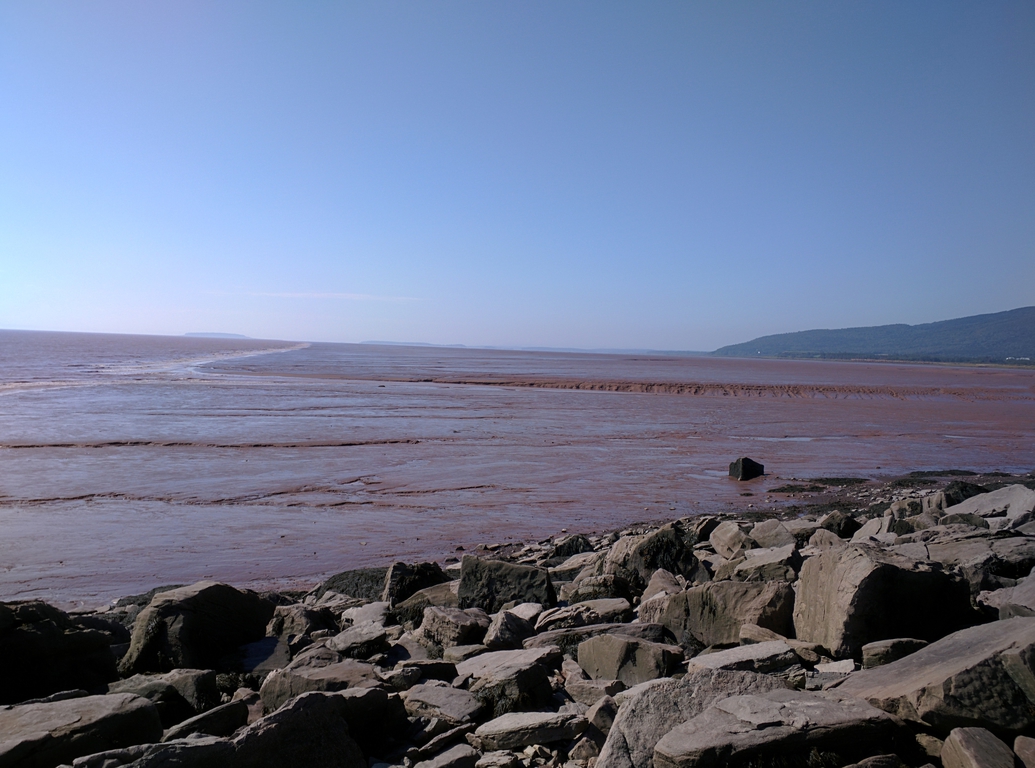
There are lots of rocks like the one in the picture below along the beach. The rock is very soft here, and the deepest areas of carving indicate where the waves spend more time than elsewhere. Remember that the tide comes in and out like a sine wave, rapidly in the middle, but slowly at the top and bottom. So as the tide peaks out, it spends more time in the few feet near the top, and those rocks get more wear.
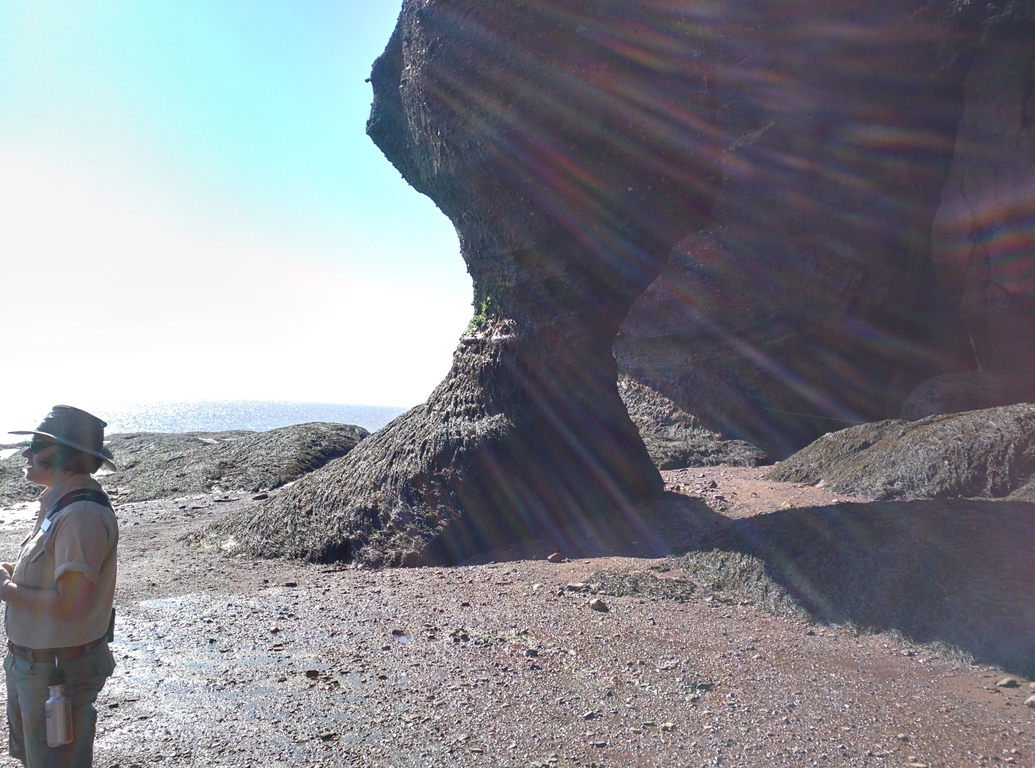
Tags: Uncategorized
September 17th, 2015 · 1 Comment
We camped last night in the Fundy National Park, but we didn’t get out to see the Bay until today.
The Bay of Fundy is famous for having the highest tides in the world due to a fortuitous combination of bay shape and size. Tides can have up to 50 feet difference from low to high, though we’re here at a point in the moons phase where they are only running about 30 feet.
We came to Hopewell Provincial Park in the afternoon to coincide with high tide, and took some pictures. We’ll come back tomorrow morning at low tide and compare.

Stay tuned.
Tags: Uncategorized
September 17th, 2015 · 3 Comments
The bridge connecting Prince Edward Island with New Brunswick about 14 km long, or about 9 miles. Here’s a picture of it taken from the NB end.
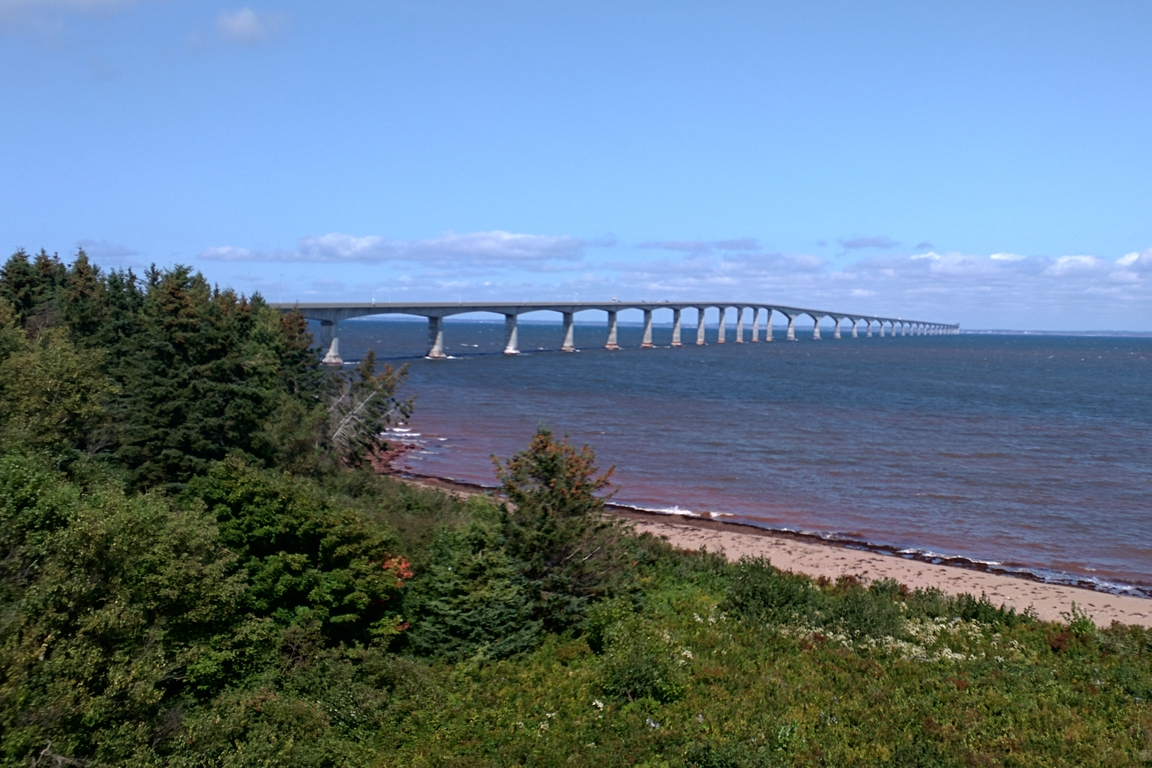
We drove over from PEI yesterday. The bridge is only 2 lanes, one in each direction, no passing the whole way. On the NB end, as you see from the picture, it is highly elevated to connect with the cliffs on the shore.
Obviously the ocean must not be very deep across the whole strait. Still quite an engineering feat.
Tags: Uncategorized

















